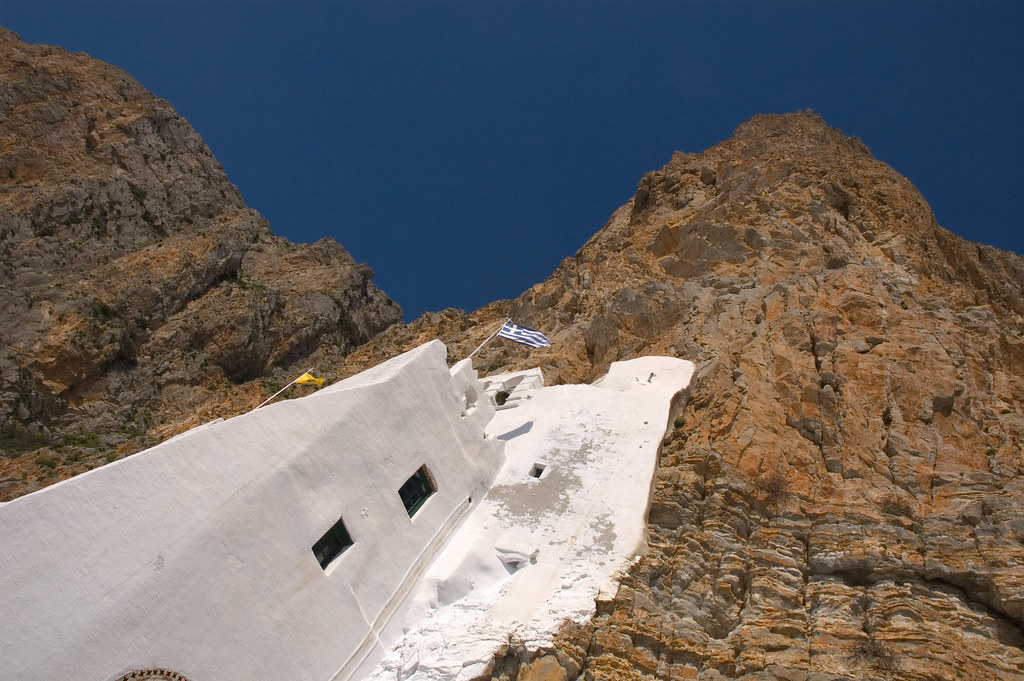
In past centuries, Greek monks tried to build monasteries in places that were hidden or difficult to access in order to protect themselves from bandits, invaders, and conquerors.
On islands, monasteries faced increased threats from pirates, so they had to be well-fortified. The most well-protected of them all survived for centuries and is still standing proud in its remote fastness as a testament to Christian Orthodox faith and devotion.
Today, some of them are still operating and are also open to the faithful and to visitors who want to admire the monumental stone buildings that stand stubbornly in place, housing generations of ascetic monks who have lived there.
Holy Monastery of Agios Ioannis Theologos—Patmos
Patmos is considered the holiest island in the Aegean. It is also called the Greek Island of the Apocalypse. It may be one of the smallest islands in the Aegean Sea, but it is home to one of the greatest treasures of Orthodoxy.

The Monastery of Agios Ioannis Theologos, or St. John the Theologian, is an Orthodox monastery founded in 1088 in the main town of Patmos. In 1999, it was declared a World Heritage Site by UNESCO.
It was built on the exact spot where Christians believe that the Apostle John wrote the Book of Revelation near the cave where he had the visions of the Apocalypse.
In 1088, Byzantine Emperor Alexios I Komnenos ceded the entire Greek island of Patmos to the monk Christodoulos. Most of the monastery was completed by Christodoulos three years later.
The exterior was fortified because of the continuing threats from pirates and Seljuk Turks, and the monastery was built on a hill higher than the cave of the Apocalypse right atop the altar of the ancient goddess Artemis.
Arriving at the monastery, the huge walls, which are a perfect example of Byzantine architecture, welcome you. Picturesque chapels, such as those of the Holy Apostles and Agios Georgios, are also located in the area.
The Holy Monastery of Agios Ioannis Theologos has been active for 932 consecutive years and continues to this day to be the guardian of Byzantine tradition and the treasures of Christianity.
Panagia Hozoviotissa—Amorgos
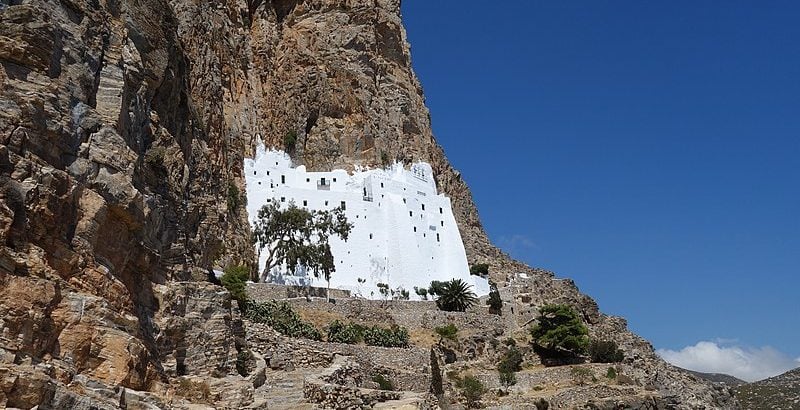
You will find the Monastery of Panagia Hozoviotissa on Amorgos clinging to a steep rock above the endless blue of Agia Anna Beach.
The Monastery of Panagia Hozoviotissa has been standing there, a bright white sentinel against the grey rock surrounding it, since the year 1088.
According to tradition, the miraculous icon of Panagia arrived by boat on the beach of Asia from Hozova in Palestine, sent by a pious woman who wanted to save the icon from the Iconoclasts.
It is remarkable that the icon arrived there because the location was rumored to have been inhabited by demons.
The people of Amorgos began the construction of a church to honor the Virgin Mary, but every morning, they saw that what they had built the day before had collapsed—that is, until one day they saw their tools hanging high in an inaccessible place on the rock.
They took this to mean that the will of the Virgin Mary was to build her small church up there on that spot.
The monastery stands there today, imposing and pristine, perched on steep cliffs 300 meters (984 feet) above sea level. Incredibly, it is only visible from the sea.
The feast of the Virgin Mary is celebrated on November 21st on the island, and a big festival is organized in her honor there.
On the eve of the great feast, people who wish to participate can spend the night in the monastery. It’s a unique experience since being there at night, you feel like you’re up in the sky, and you become one with the stars that seem to touch the rock.
At dawn, the spectacle is stunning, with the sun rising up out of the sea and the incredible colors of the rising sun reflected on the waters. The celebration is very festive and attracts people from all over Greece. The monks have cod, fava, fish, wine, raki, pasteli, and other foods for sale on the day.
Under the monastery, the beach of Agia Anna is well known for its crystal-clear waters, and the chapel is considered one of the most popular for weddings. The film The Big Blue was shot there, making Amorgos famous all over the world.
Monastery of the Taxiarches—Serifos
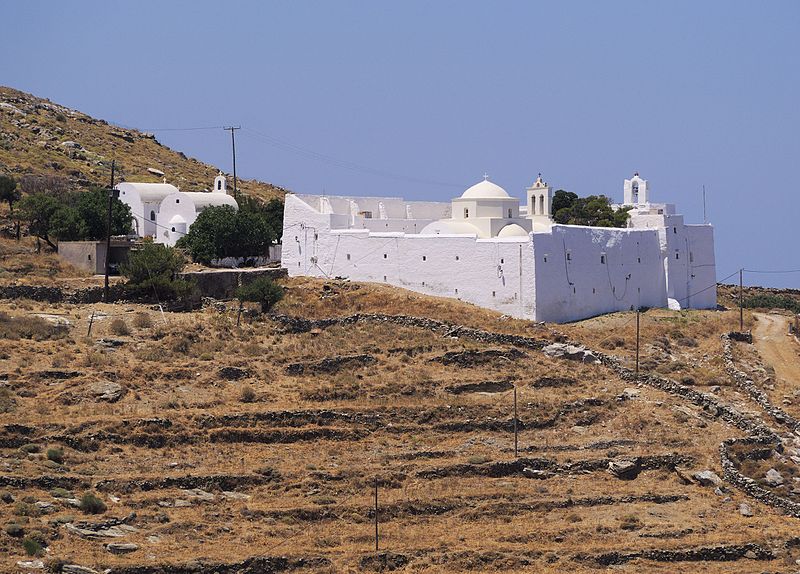
Between the crossroads to Platy Gialos and the village of Galani in the northern part of Serifos is the church of Panagia Zoodochou Pigis with its small cemetery, and opposite, the men’s Monastery of Taxiarches, dedicated to the patron saints of the Greek island, the Archangels Gabriel and Michael.
Although there is some confusion about the exact time of the foundation of the monastery, the prevailing view is that it was built in 1572.
However, it is certain that it was rebuilt in 1659 after it was damaged. A low blue door at the top of the steep stairs leads inside the monastery and its own simple, unpretentious and reverent space.
Its architectural style is unique, and it is worth noting that from 1617 to 1911, there was a school operating there.
It was looted several times during the Venetian occupation, and pirates never left it alone. This is the reason that its looks like the fortress that we see today.
The Panagia Chrysoskalitissa Monastery—Chania
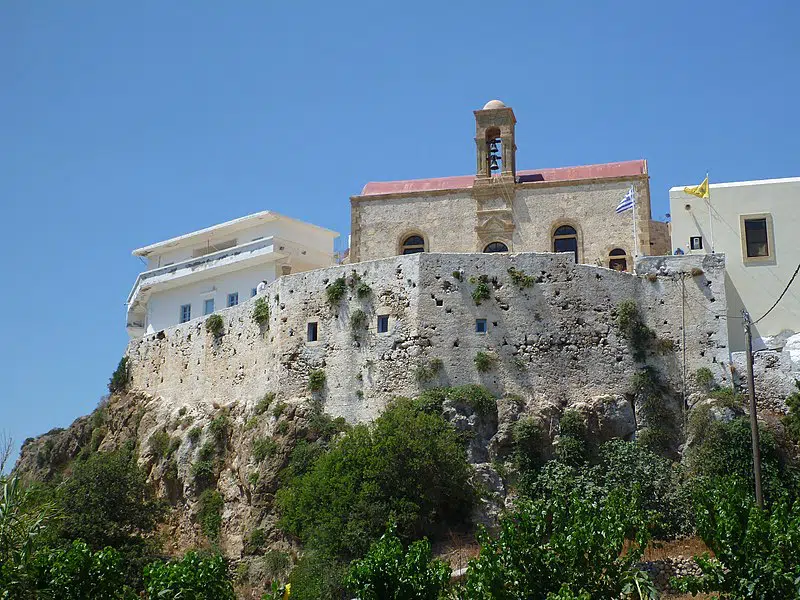
One of the most popular Greek monasteries, due to its impressive architecture and the short distance from Elafonissi, is the Holy Monastery of Panagia Chrysoskalitissa.
The monastery is located 72 km (45 miles) southwest of Chania, Crete on a 35 meter (115-foot) tall rock overlooking the Libyan Sea.
It is a white monastery with fortress-like architecture. In fact, it is one of the most important monuments of southwestern Crete.
The church of the monastery is dedicated to the Holy Trinity and the Assumption of the Virgin Mary.
The year of the monastery’s founding is unknown. However, according to tradition, it was built when a farmer found an icon of the Assumption on a rock. The icon is said to have been hidden there during the Iconoclasm period from 726 to 842 AD, and the icon is still in the church at the monastery.
The monastery is mentioned in the Venetian census of 1637 as Panagia Gounoskalitissa. The name Chrysoskalitissa is due to the last of the 98 steps of the monastery, which, it is said, was made of gold and was sold during the Ottoman occupation. However, legend has it that those who are true believers still see the golden step.
In addition to the unique architecture and the imposing view, once in the Monastery of Chrysoskalitissa, you will admire the legendary icon of the Assumption of the Virgin Mary in the small chapel, which is said to have been constructed 1,000 years ago.
The Zoodochou Pigis—Andros
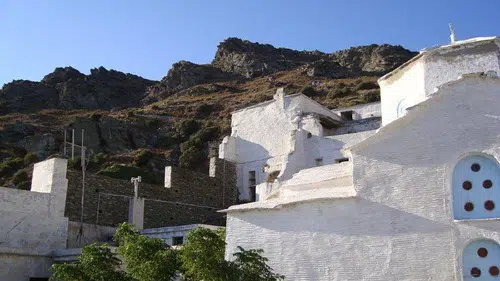
The largest monastery of Andros is the monastery of Zoodochou Pigis, or the “Fountain of Life.” Locals call it “Agia,” and it celebrates its feast on the first Friday after Easter Sunday. It is located between Gavrio and Batsi.
It is unknown when it was built. However, there is unconfirmed information that during the Byzantine years, it was a school and turned into a monastery in 842 by Empress Theodora.
It is also reported that many noble Andriotes were educated in the school, which produced several priests, bishops, and patriarchs.
The monastery is mentioned for the first time in a document of 1400, while in its church there is an icon with a date of 1325.
It was renovated during the 16th century and then again in the 20th, and its original Byzantine form was altered. In 1928, the monastery was converted into a convent, and today, only one elderly nun lives there.
The church of the monastery is in the Byzantine style, and its painted artworks date back to the post-Byzantine period.
Icons from the 14th and 16th centuries are still housed there as well. In the monastery, there is an important library with many books and manuscripts, a museum with sacred vestments and utensils, and a small collection of prehistoric tools found on the island.
See all the latest news from Greece and the world at Greekreporter.com. Contact our newsroom to report an update or send your story, photos and videos. Follow GR on Google News and subscribe here to our daily email!



